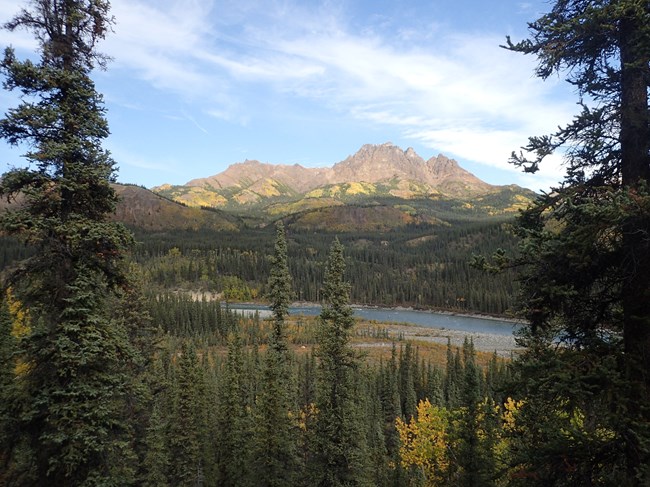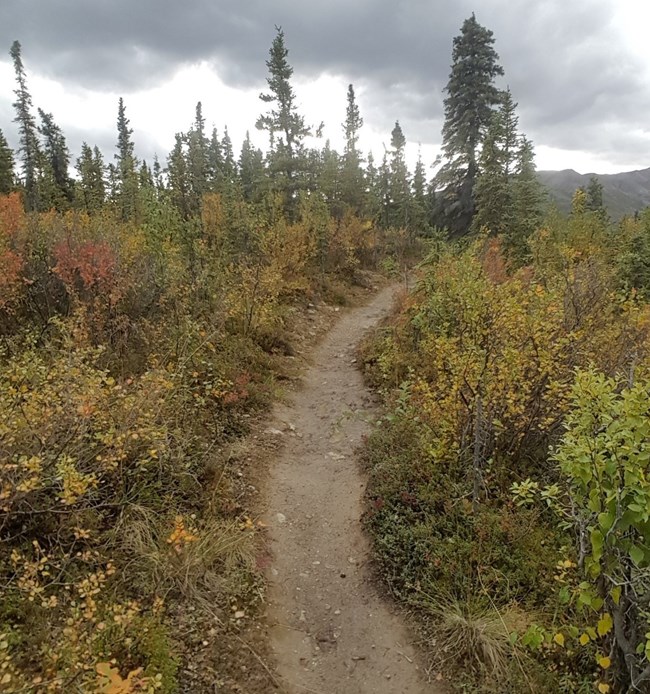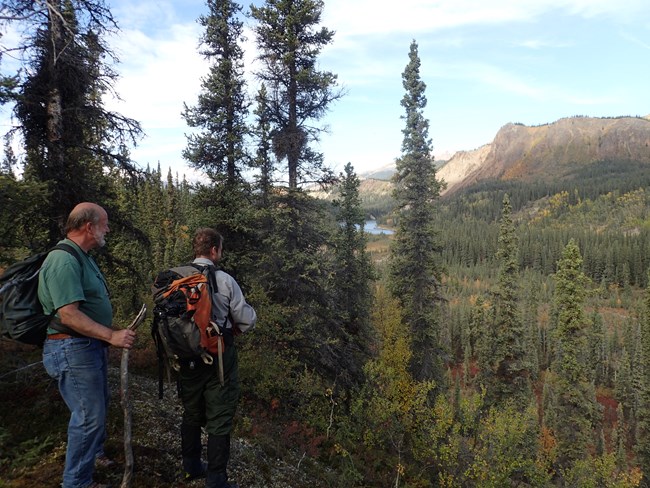|
Denali National Park began developing approximately 17 miles of trails in the area of the park between the Nenana River and the Parks Highway (the ‘Nenana River corridor’ - see map below) in 2023. This project is intended to encourage many visitors to interact with the landscape of the park in a way that does not depend on access to the Park Road and does not impact wilderness. These ideas are described and analyzed in an Environmental Assessment which can be read in full on the Planning, Environment, and Public Comment (PEPC) page for the Nenana River Trails project. Background
NPS Photo The Nenana River corridor extends from the Park Road entrance south to milepost 231 on the Parks Highway and is bounded to the west by the Parks Highway and to the east by the Nenana River. This area is primarily a mixed white spruce broadleaf forest, a taiga forest community comprised largely of white spruce and aspen along with black spruce, willows, Labrador tea, blueberry, low bush cranberry, and sphagnum moss. It provides habitat for many avian species, small mammals, and larger mammals such as moose and bears. This non-wilderness area has been considered for trail construction since at least the 1997 Frontcountry Development Concept Plan. More recently, the Nenana River corridor was chosen as part of the route for the proposed Alaska LNG pipeline which would be mostly buried through the area. A wayside and trailhead was constructed at the southern end of this area at Parks Highway milepost 231 in 2022. The Alaska Department of Transportation-led Parks Highway Planning and Environmental Linkages Study considers transportation improvements along the Parks Highway through the Nenana River corridor, including ideas for non-motorized and pedestrian access. Trails developed in this area have the potential to:
Project OverviewThe Nenana River Trails project will create a total of approximately 17 miles of hiking, multiuse, and accessible trail in the Nenana River corridor (shown as the “proposed action” in the map below). Construction will be completed in five phases: 
NPS Image 
NPS Photo Of the 17 miles of total trail, approximately eight miles will be a Class IV multiuse trail designed for safe concurrent use by bicyclists and pedestrians. The multiuse trail will be approximately eight feet wide and will have a primarily crushed gravel surface. Trail location and design will create adequate sightlines, grades, and curves to reduce wildlife and user conflicts as well as encourage moderate cycling speeds. An additional approximately nine miles of trail in the project area will be open to pedestrians only. The majority of these hiking trails will be Class II, approximately one to two feet wide with a primarily natural surface. The southernmost mile of the hiking trails will form a universally accessible loop from the trailhead at mile 231 of the Parks Highway in conjunction with the southernmost mile of the multiuse trail. This mile of accessible pedestrians-only trail will be approximately 5 feet wide and will have a crushed gravel surface. 
NPS Photo In addition to wayfinding signage on the trails, there may be other facilities constructed along the trails, including benches, interpretive signs, or overlook areas. These additional facilities will be concentrated near trailheads. An approximately eight-foot-wide bridge allowing for safe concurrent use by pedestrians and cyclists will cross Riley Creek and connect the trail system to the Riley Creek day use area on the northern end of the project area. The bridge could be constructed as a single span of 250’ or as two 125’ segments. One 125’ span would be sufficient to cross the stream channel, while a second 125’ span would improve accessibility and keep the trail out of the floodplain on the north side of Riley Creek. No other facilities will be constructed on or near the trails under the plan. All trails will be open for their respective uses year-round. Although the 2020 Winter and Shoulder Season Visitor Services EA authorized motorized grooming of trails in this area, the NPS does not intend to formalize any winter recreational activities or trails in the project area at this time. Commercial use will be allowed on the trails under existing laws, NPS policies, and park planning documents. Any novel commercial uses that might be proposed in the future would be evaluated by standard park compliance and commercial services processes. NEPA and NHPA ComplianceThe National Environmental Policy Act (NEPA) mandates an environmental assessment of any proposed federal action that has the potential to “significantly affect the quality of the human environment." Section 106 of the National Historic Preservation Act (NHPA) requires that federal agencies identify and assess the effects their actions may have on historic properties and consider public views and concerns about historic preservation issues when making final project decisions. Compliance with the NHPA is conducted concurrent with, but as a separate process to, the NEPA compliance process. Environmental and cultural compliance for the Nenana River Trails project was formally initiated in October 2022 and was completed in April 2023. The Environmental Assessment (EA) considered the environmental consequences of a “no action alternative”, “construct multiuse and pedestrian trails alternative” (the selected alternative), “wait for the railroad realignment alternative”, and a “trails and campgrounds alternative”. Key issue topics of concern that were analyzed in the EA included human-wildlife interactions, wildlife habitat and movement patterns, removal and disturbance of vegetation and wetlands, vegetation composition change, introduction of invasive plant species, cultural resources disturbance, development in an undeveloped area, loss of trailless terrain, and multimodal connectivity. As a result, the project includes mitigations to reduce impacts to wildlife, vegetation, wetlands, cultural resources, soundscapes, visitor use, and visitor experience. The NPS hosted two public meetings in March 2023 to discuss the analysis and provide information to aid the public in reviewing and commenting on the compliance document. Watch a recording of the virtual meeting. After careful consideration of resource impacts, consultation with stakeholders, and review of public comments, the NPS concluded that the Nenana River Trails project would not have a significant effect on the environment. The Finding of No Significant Impact (FONSI) was approved by the NPS Alaska Regional Director and released to the public in April 2023. 
NPS Photo How Can I Get Involved?Learn about other plans and become familiar with the Denali Planning Portfolio. Check the NPS Planning, Environment, and Public Comment (PEPC) website for documents available for review and comment. If you have questions, please email us. Thank you for providing feedback! |
Last updated: April 1, 2024
